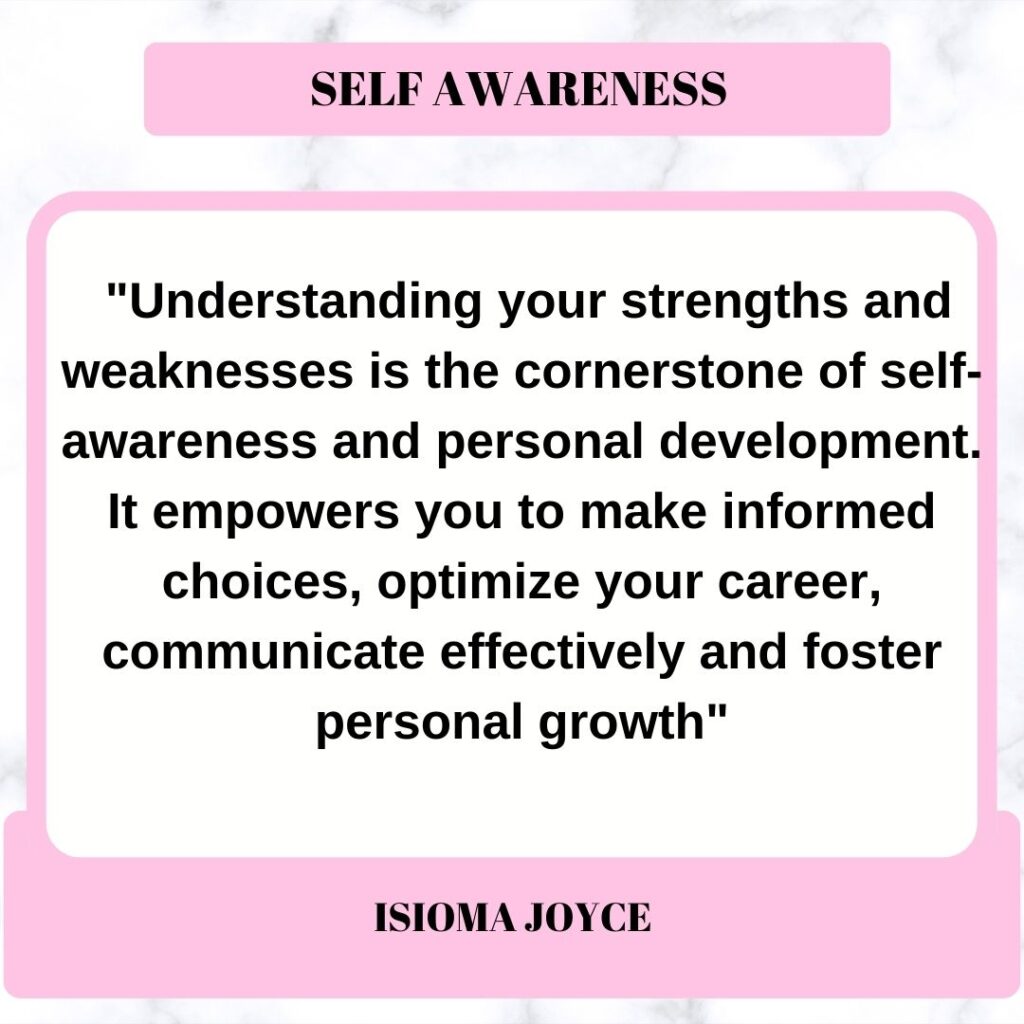
Understanding your strengths and weaknesses is a pivotal aspect of personal growth and self-awareness. It lays the foundation for making informed decisions, setting achievable goals, and maximizing your potential.
Identifying your strengths involves recognizing the areas where you excel, where tasks seem effortless, and where you find joy. Take note of compliments and positive feedback from others, as these often point to your strengths. Additionally, consider what activities energize you and where you’ve achieved notable success.
Once identified, leverage your strengths to your advantage, both personally and professionally. Delegate tasks that align with your weaknesses or seek opportunities for growth in those areas. Knowing your strengths and weaknesses empowers you to navigate life with greater clarity, resilience, and the ability to continuously improve yourself. It’s a journey towards self-mastery and success.
Certainly, here are five points on how to identify your strengths and weaknesses:
1. Self-Reflection: Take time for introspection. Reflect on your past experiences, both personal and professional, and consider the activities where you excel and those where you face challenges. Self-awareness is the first step in identifying your strengths and weaknesses.
2. Feedback from Others: Seek input from friends, family, colleagues, and mentors. Often, others can provide valuable insights into your strengths and weaknesses based on their observations and experiences working or interacting with you.
3. Self-Assessment Tools: Consider using self-assessment tools or personality tests such as the Myers-Briggs Type Indicator (MBTI), StrengthsFinder, or the Enneagram. These tools can provide structured assessments of your personality traits, strengths, and areas for growth.
4. Set Goals and Monitor Progress: When you set personal or professional goals, you may notice patterns of success or difficulty in achieving them. These patterns can reveal areas of strength and weakness. Regularly tracking your progress towards your goals can help you gain insights into your capabilities.
5. Skill Audits: Conduct a skill audit by making a list of your technical, soft, and transferable skills. Evaluate your proficiency in each skill and identify areas where you feel particularly skilled or where you may need improvement. This process can be instrumental in recognizing your strengths and weaknesses.
Ultimately, identifying your strengths and weaknesses is an ongoing process that combines self-awareness, feedback from others, assessment tools, goal setting, and skill evaluation. By actively engaging in this self-discovery, you can harness your strengths and work on your weaknesses to achieve personal and professional growth.
Benefits of Understanding your strengths and weaknesses
1. Career Alignment: Understanding your strengths and weaknesses can significantly impact your career choices. When you recognize your strengths, you can seek out roles and industries where you can excel and find fulfillment. Conversely, being aware of your weaknesses helps you avoid career paths that may constantly challenge you in areas where you struggle, ultimately leading to job satisfaction and success.
2. Effective Communication: Knowing your strengths and weaknesses can enhance your communication skills. When you’re aware of your strengths, you can confidently contribute in areas where you excel, sharing your expertise and insights with others. Understanding your weaknesses also allows you to communicate your limitations honestly, enabling effective teamwork and collaboration.
3. Goal Setting: Identifying strengths and weaknesses is fundamental to setting realistic and achievable goals. By leveraging your strengths, you can set ambitious objectives that align with your capabilities. Simultaneously, acknowledging weaknesses enables you to create action plans to address them or find alternative routes to your goals.
4. Personal Growth: Recognizing your strengths and weaknesses fosters personal growth and development. Your strengths can be refined and further honed, while your weaknesses can be transformed into areas of improvement. This self-awareness is the first step towards self-improvement and continuous learning.
5. Effective Decision-Making: Your awareness of strengths and weaknesses influences your decision-making process. When faced with choices, you can evaluate which options align better with your strengths, increasing the likelihood of positive outcomes. Similarly, understanding your weaknesses allows you to make informed decisions about seeking assistance or delegating tasks to others to mitigate potential pitfalls.
In summary, understanding your strengths and weaknesses empowers you to make informed choices, optimize your career, communicate effectively, set meaningful goals, foster personal growth, and enhance your decision-making abilities. It is a cornerstone of self-awareness and personal development.

